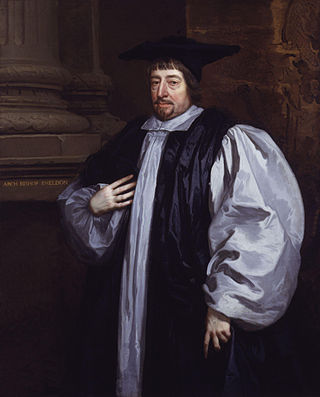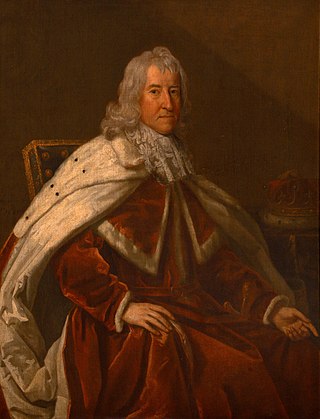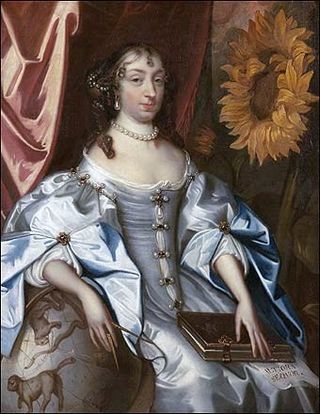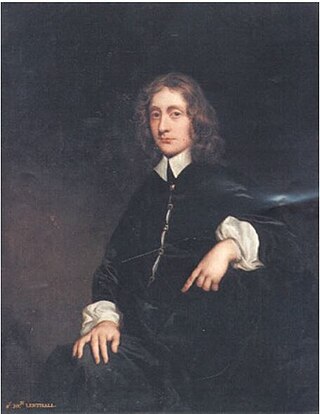Related Research Articles

Samuel Pepys was an English writer and Tory politician. He served as an official in the Navy Board and Member of Parliament, but is most remembered today for the diary he kept for almost a decade. Though he had no maritime experience, Pepys rose to be the Chief Secretary to the Admiralty under both Charles II and James II through patronage, diligence, and his talent for administration. His influence and reforms at the English Admiralty were important in the early professionalisation of the Royal Navy.

The Stuart Restoration was the reinstatement in May 1660 of the Stuart monarchy in England, Scotland, and Ireland. It replaced the Commonwealth of England, established in January 1649 after the execution of Charles I, with his son Charles II.

Gilbert Sheldon was an English religious leader who served as the Archbishop of Canterbury from 1663 until his death.

Sir John Wildman was an English politician and soldier.

John Robartes, 1st Earl of Radnor was an English politician, peer and military officer who fought for the Parliamentary cause during the English Civil War. He retired from public life before the trial and execution of Charles I (1649) and did not take an active part in politics until after the Restoration in 1660. During the reign of Charles II he opposed the Cavalier party. Toward the end of his life he opposed the more extreme Protestant groups, led by Anthony Ashley Cooper, 1st Earl of Shaftesbury, who refused to accept the succession of James because he was a self-declared Catholic.

Henry Pierrepont, 1st Marquess of Dorchester, PC, FRS, FRCPArchived 6 October 2020 at the Wayback Machine was an English peer. He was the son of Robert Pierrepont, 1st Earl of Kingston-upon-Hull, and his wife, the former Gertrude Talbot, daughter of George Talbot and Elizabeth Reyner, and cousin of the Earl of Shrewsbury.

Edward Montagu, 1st Earl of Sandwich, 27 July 1625 to 28 May 1672, was an English military officer, politician and diplomat from Barnwell, Northamptonshire. During the First English Civil War, he served with the Parliamentarian army, and was a Member of Parliament at various times between 1645 and 1660. Under The Protectorate, he was also a member of the English Council of State and General at sea.

″

Sir Isaac Penington was an English politician who sat in the House of Commons from 1640 to 1653. He was Lord Mayor of London in 1642 and a prominent member of Oliver Cromwell's government.

Sir Richard Wynn, 4th Baronet (1625–1674) was a Welsh landowner who was Sheriff of Caernarvonshire and twice a member of Parliament for the same county.

Charles MacCarty, Viscount Muskerry, called Cormac in Irish, commanded a royalist battalion at the Battle of the Dunes during the interregnum. He was heir apparent to Donough MacCarty, 1st Earl of Clancarty but was killed at the age of 31 at the Battle of Lowestoft, a sea-fight against the Dutch, during the Second Anglo-Dutch War, and thus never succeeded to the earldom. He was buried in Westminster Abbey.
William Sydenham was a Cromwellian soldier; and the eldest brother of Thomas Sydenham. He fought for Parliament and defeated the Royalists in various skirmishes in Dorset. He was member of the various parliaments of the Commonwealth, avowal conservative principles, and defended the liberties of Englishmen. In 1654 made councillor and commissioner of the treasury by Oliver Cromwell. Took the side of the army against Parliament. In 1660, after the Protectorate, and before the Restoration, he was expelled from the Long Parliament. After the Restoration, he was perpetually incapacitated from holding office by the Indemnity and Oblivion Act.

Sir Robert Tichborne was an English merchant, politician, author and military officer who served as Lord Mayor of London in 1656. He was a regicide of Charles I.
John Claypole was an officer in the Parliamentary army in 1645 during the English Civil War. He was created Lord Claypole by Oliver Cromwell, but this title was not recognised after the Restoration of 1660.

Elizabeth Claypole was the second daughter of Oliver Cromwell, Lord Protector of the Commonwealth of England, Scotland and Ireland, and his wife, Elizabeth Cromwell, and reportedly interceded with her father for royalist prisoners. After Cromwell created a peerage for her husband, John Claypole, she was known as Lady Claypole. She was buried in Westminster Abbey.
Bridget Bendish (1650–1726), was a daughter of General Henry Ireton and Bridget, Oliver Cromwell's eldest daughter. She was born in Attenborough, Nottinghamshire, England. She married Thomas Bendish, a distant relative of Sir Thomas Bendish, 2nd Baronet, in 1670. Bridget died early in 1726 at age 76 and was buried in Great Yarmouth.

Sir John Lenthall was an English Member of Parliament. He was elected MP for Gloucester in 1645, knighted by Oliver Cromwell in 1658 and made Governor of Windsor Castle from 1657 to 1660. After the 1660 Restoration of the Monarchy he was pricked Sheriff of Oxfordshire for 1672–73 and knighted a second time by Charles II in 1677.
Sir Robert Slingsby, 1st Baronet (1611–1661) was an English baronet, author and Naval commander, and in his last years a much-loved colleague of Samuel Pepys.
During the Protectorate period (1653–1659) of the Commonwealth of England, the Lord Protector reserved the power previously held by the monarch to confer knighthoods, baronetcies and peerages.
References
- Firth, C.H. (1892). . In Lee, Sidney (ed.). Dictionary of National Biography . Vol. 29. London: Smith, Elder & Co. p. 42. (see paragraph at the end of the main article)
 Lee, Sidney, ed. (1903). "Ireton, John". Index and Epitome. Dictionary of National Biography . Cambridge University Press. p. 42.
Lee, Sidney, ed. (1903). "Ireton, John". Index and Epitome. Dictionary of National Biography . Cambridge University Press. p. 42.
Attribution
 This article incorporates text from this source, which is in the public domain :Brown, Cornelius (1896). "Attenborough, Kingston-on-Soar, and Bradmore". A history of Nottinghamshire.
This article incorporates text from this source, which is in the public domain :Brown, Cornelius (1896). "Attenborough, Kingston-on-Soar, and Bradmore". A history of Nottinghamshire.{{cite book}}:|website=ignored (help)